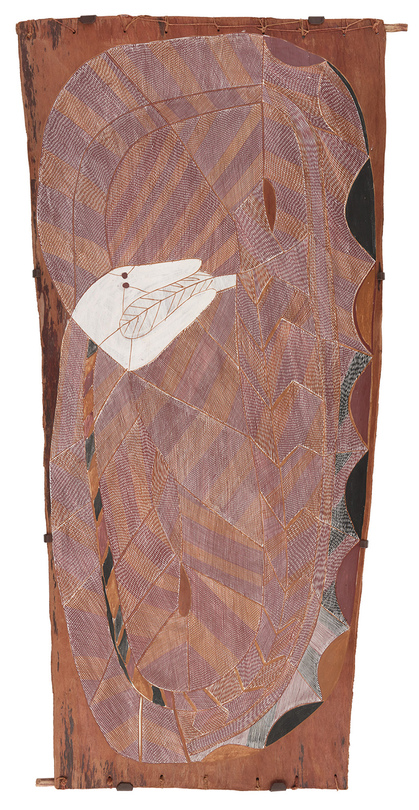-
From Current Issue
-
- Editor’s Letter Fire in the Heart
- Reviews I Gusti Ayu Kadek Murniasih
- Reviews 11th Seoul Mediacity Biennale: “One Escape at a Time”
- Dispatch Networked China
- One on One Monira Al Qadiri on Yukio Mishima
- Essays The rise of independent art spaces in pandemic-era Shanghai
- Features Tuan Andrew Nguyen
- Table of Contents
- Web Exclusives
- Archive
- Subscribe

R
E
V N
E
X
T
Installation view of JOHN MAWURNDJUL’s “I Am the Old and the New” at the Museum of Contemporary Art Australia, Sydney, 2018. Photo Jessica Maurer. All images copyright and courtesy the artist.
With “I Am the Old and the New,” Sydney’s Museum of Contemporary Art Australia and the Art Gallery of South Australia, in association with Aboriginal arts center Maningrida Arts and Culture, jointly present a long overdue celebration of John Mawurndjul, one of the foremost Indigenous bark painters in the country. Born in Arnhem Land, Northern Territory, Mawurndjul had achieved critical international acclaim by the late 1980s, shown in the Centre Pompidou’s ground-breaking 1989 group exhibition “Magiciens de la Terre” (characterized by curator Jean-Hubert Martin as “the first truly international exhibition of worldwide contemporary art,” a claim that is still debated today), as well as retrospectives in 2005 at Basel’s Museum Tinguely, and the Sprengel Museum in Hannover in 2006. More than a decade later, Australia has finally agreed to play host to the first major survey of Mawurndjul’s career in his home country.
“I Am the Old and the New” traces the artist’s oeuvre across a 40-year period, focusing on his mastery of rarrk, a Kuninjku term for a traditional, fine-painted cross-hatching style. From Mawurndjul’s early fascination with the rainbow serpent Ngalyod, to more recent depictions of the Mardayin rite, the exhibition encompasses the artist’s deft handling of old and new Indigenous identities and artistic techniques.
Exploring the artist’s relationship to his ancestral homeland, the exhibition takes the audience on a journey to various Indigenous sites—all connected to the Aboriginal Dreamtime—that are central to Mawurndjul’s works. Beginning with Barrihdjowkkeng, a yirridjdja moiety place belonging to the Darnkolo clan, Ngalyod – The Rainbow Serpent (1985) showcases Mawurndjul’s use of
white, yellow and red earth pigments sourced from the site. The mythological entity is portrayed in a spiral form with its body covered in finely drawn rarrk, on a piece of bark from the Eucalyptus tetrodonta, a native Australian tree more commonly known as Darwin stringybark. The accompanying artist statement tells the story of Ngalyod piercing the ground of this site, where yawkyawk (young female spirits) live. The artist explains that he had once camped at Barrihdjowkkeng when there was no water in the river, so he dug a well and, finding water, was able to drink from it. By juxtaposing his own experiences with native mythologies, Mawurndjul expresses the deeply sacred connection between Indigenous peoples and their homelands, where subsistence and spirituality are intertwined.
On an opposite wall, a series of dazzling bark paintings hang
beside one another, depicting traditional ceremonial designs
that are typically painted onto the participant’s body. Mardayin Ceremony Theme 2 (1996), for instance, transfers the titular sacred performance enacted by the Darnkolo clan at Kakodbebuldi onto bark through thin and delicate cross-hatching strokes that create a visual effect of prismatic grids. To the uninitiated, the work appears to be a series of geometric abstractions, but to those within the Indigenous community, each mark is loaded with meaning and ancestral significance. Mawurndjul has stated that he believes it
is necessary to paint these images so that non-Indigenous people may have the opportunity to cultivate a better understanding of Aboriginal culture. Nonetheless, he maintains an air of secrecy in these works by focusing on symbols and patterns associated with the sites and rituals rather than overt figuration, respecting the private sanctity of the ritual world of Aboriginal men.
The exhibition continues with a series of upright bark logs (Lorrkkon) scattered across a darkened space, some clustered in groups, others alone. The logs tower over viewers as they walk around to get a closer view of the striking designs composed of symbols that are reminiscent of those found in the Mardayin paintings. Wall text penned by Mawurndjul reveals that these hollow logs are part of a traditional burial process, whereby logs are filled with the bones of the deceased and left to decay within the natural surroundings.
Installation view of JOHN MAWURNDJUL’s “I Am the Old and the New” at the Museum of Contemporary Art Australia, Sydney, 2018. Photo Jessica Maurer.
By revealing aspects of such intimate rituals, Mawurndjul plays a dual role, preserving his heritage while experimenting with refreshing methods of representing Indigenous culture. “I Am the Old and the New” demonstrates this duality visible throughout his oeuvre, from his powerful earlier depictions of mythological creatures to later, subtler works sharing his deep knowledge and connection to ancestral lands.
John Mawurndjul’s “I Am the Old and the New” is on view at the Museum of Contemporary Art Australia, Sydney, until September 23, 2018. A smaller version of the exhibition will tour regionally to eight locations across Australia until 2020.
To read more of ArtAsiaPacific’s articles, visit our Digital Library.





